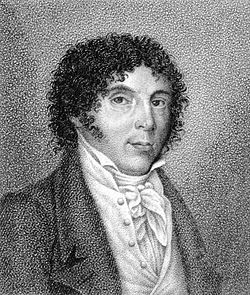Stefano Pavesi
(Casaletto Vaprio, 1779 — Crema, 1850)
 Stefano Pavesi, born in Casaletto Vaprio, near Crema, in 1779, was considered in 1809, by a prestigious French musical magazine, within the five best composers active in Italy. He studied under the guidance of Piccini at the prestigious conservatory of S. Onofrio in Naples. Implicated in the revolutionary uproar in the city in 1799, Pavesi was forced to escape to France and then to Geneva. He came back to Crema soon afterwards and completed his studies under the guidance of Gazziniga, maestro in the Cathedral Chapel. In 1802, he moved to Venice, where, the following year, his first farce was staged, adjudged opera of great value by all the musical critics of the time and also by the composer Mayr, Donizzetti’s maestro, and by the librettist Foppa. The following years saw Pavesi earn many successes. He obtained increasing approval by the public, critics and colleagues. He composed around 70 serious and comedic operas performed in various Italian cities, often gaining notable success. In 1818 Pavesi was appointed maestro of Crema’s Cathedral Chapel and, between 1826 and 1830, he directed the Court Theatre of Vienna for six months of the year. Among his most important lyrical operas, characterised by a notable inventive melody and orchestral mastery, were: La Fiera (1804), La festa della rosa (1808), Ser Marcantonio (1810, on the same libretto of Don Pasquale by Donizzetti), and Fenella (1831).
Stefano Pavesi, born in Casaletto Vaprio, near Crema, in 1779, was considered in 1809, by a prestigious French musical magazine, within the five best composers active in Italy. He studied under the guidance of Piccini at the prestigious conservatory of S. Onofrio in Naples. Implicated in the revolutionary uproar in the city in 1799, Pavesi was forced to escape to France and then to Geneva. He came back to Crema soon afterwards and completed his studies under the guidance of Gazziniga, maestro in the Cathedral Chapel. In 1802, he moved to Venice, where, the following year, his first farce was staged, adjudged opera of great value by all the musical critics of the time and also by the composer Mayr, Donizzetti’s maestro, and by the librettist Foppa. The following years saw Pavesi earn many successes. He obtained increasing approval by the public, critics and colleagues. He composed around 70 serious and comedic operas performed in various Italian cities, often gaining notable success. In 1818 Pavesi was appointed maestro of Crema’s Cathedral Chapel and, between 1826 and 1830, he directed the Court Theatre of Vienna for six months of the year. Among his most important lyrical operas, characterised by a notable inventive melody and orchestral mastery, were: La Fiera (1804), La festa della rosa (1808), Ser Marcantonio (1810, on the same libretto of Don Pasquale by Donizzetti), and Fenella (1831).
He also wrote numerous scores of sacred music, among them, Infelix Catharina, a magnificent composition written to commemorate the tragedy of Caterina of Uberti. Stefano Pavesi died in Crema in 1850.

